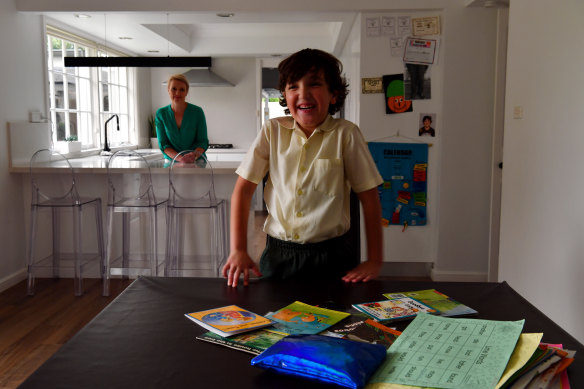International test results reveal Australian students perform no better academically if they attend a private school over a public school once socio-economic background is taken into account.
The latest Program for International Student Assessment (PISA) results released last week shocked parents, educators and government ministers. They showed Australian students had failed for the first time to exceed the OECD average in maths, and also tumbled down global rankings in reading and science.

Aristea Marakas chose to send her son Christian to the local public school instead of joining his brothers in the Catholic system.Credit: Sam Mooy/The Sydney Morning Herald
Raw scores showed students at independent schools were about one-and-a-half years ahead of those at government schools, and almost one year ahead of students at Catholic schools.
But these distinctions disappeared once students’ and schools’ socio-economic background was taken into consideration – except that public schools outperformed Catholic schools in mathematics.
"What that means is that socio-economic background has a really high effect on outcomes," said PISA national program director Sue Thomson. She said an advantaged student would perform the same in an advantaged government, private or independent school, whereas a student from a poor background could be expected to do better in those environments.
NSW Secondary Principals' Council acting president Craig Petersen said the PISA results highlighted that "in terms of which school it is best to go to, it's your local school".
"The differences between sectors is not as great as people might think it is," he said.
"What’s reflected is what we’d expect: good teaching is occurring in all of our schools in NSW, but public schools do carry the bulk of disadvantage. The degree of inequity in Australia is among the largest in the western world and something we need to address."
When south Sydney mum Aristea Marakas was choosing a school for her youngest child Christian, she opted against the Catholic school she picked for her eldest two sons and enrolled him in the public system instead. She was encouraged by the school's focus on phonics, and says he will continue at the local high school when he finishes year 6.
"Christian comes home singing songs and sounding out letters," she said. "It's neck and neck with where my older boys were at this point. Knowing what I know now, I would have put them in the public system because I don’t see a difference in their education."
Adrian Piccoli, director of the Gonski Institute for Education at UNSW and a former state education minister, said inequality was "even worse" within the public system, which in NSW includes almost 50 selective schools that have student populations with a high educational advantage.
"The PISA results trend the same across all three sectors [so the problem] is not funding," he said.
"One of the structural issues we have in Australia that separates us from other countries [is] the segregation of students not just between government and non-government schools, but within the government sector.
"If you put 20 kids with behaviour problems in one school, you’re going to have problems."
Professor Piccoli said he did not believe the PISA results would shift parents' decision-making. "Parents don’t just look at academic results when they choose a school, they look at behaviour, peer groups and [reputation]," he said.
Catholic Schools NSW chief executive Dallas McInerney said PISA did not test attributes such as the "the education of the whole person, character education, and values – which are a key offering of Catholic Schools".
"Catholic schools have a proven track-record of preparing students for a successful transition to post-school life,” he said. “NSW Catholic Schools are the leading sector for students in work or education post-school.”
While independent schools recorded the greatest number of high achievers and percentage of students who attain the national standard, they have declined the furthest as a sector in reading and scientific literacy since 2009. The Catholic sector has recorded the largest decline in mathematics.
Geoff Newcombe, chief executive of the Association of Independent Schools NSW, said the overall decline across all three sectors was of "greater concern".
"We also need to be careful about the types of conclusions we draw from the PISA results," he said. "PISA is a particular type of assessment, testing a relatively small national sample of students using a narrow measure of student performance. It should be considered alongside other assessments of individual student performance."
More than 90 per cent of the state's 500 independent schools were low-fee or no-fee, he said, and "all sectors educate students from families across the socio-economic spectrum".